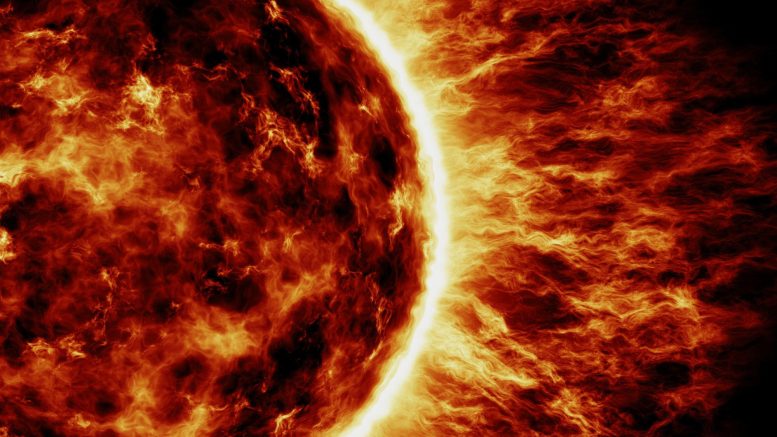
In a new study conducted by a team of physicists and nearly 1,000 undergraduate students, research findings published in The Astrophysical Journal suggest that solar flares may not be responsible for superheating the sun’s corona, contrary to a popular astrophysics theory. The collaborative effort analyzed the physics of over 600 real solar flares between 2020 and 2022. While the evidence points against the theory, researchers are not yet ready to rule out the possibility of “nanoflares” contributing to the heating of the corona. The study provided valuable research experience to the students involved, who contributed an estimated 56,000 hours of work to the project.
In a collaborative effort by physicists and nearly 1,000 students, a study found that solar flares may not be responsible for superheating the sun’s corona, casting doubt on a popular astrophysics theory.
For a new study, a team of physicists recruited roughly 1,000 undergraduate students at the University of Colorado at Boulder to help answer one of the most enduring questions about the sun: How does the star’s outermost atmosphere, or “corona,” get so hot?
The research represents a nearly-unprecedented feat of data analysis: From 2020 to 2022, the small army of mostly first- and second-year students examined the physics of more than 600 real solar flares—gigantic eruptions of energy from the sun’s roiling corona.
The researchers, including 995 undergraduate and graduate students, published their findings on May 9 in The Astrophysical Journal. The results suggest that solar flares may not be responsible for superheating the sun’s corona, as a popular theory in astrophysics suggests.
“We really wanted to emphasize to these students that they were doing actual scientific research,” said James Mason, lead author of the study and an astrophysicist at the Johns Hopkins University Applied Physics Laboratory.
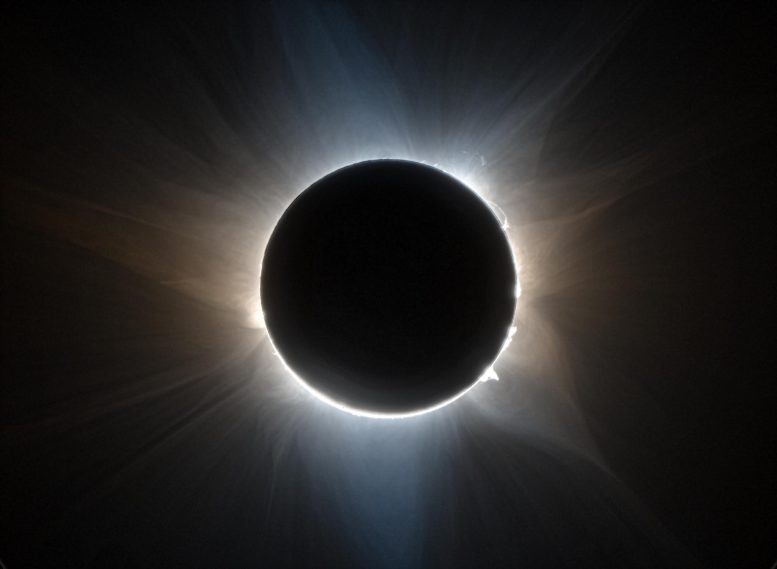
Radiation streaming from the sun’s corona becomes visible during an eclipse. The Citizen CATE 2024 project produced this false-color image of the solar corona during the 2023 total solar eclipse from Exmouth, Western Australia. The image combines two crossed polarization angles, indicated by color. Prominences, loops, and streamers are easily visible in this high-resolution image. Credit: SwRI/Citizen CATE 2024/Dan Seaton
Study co-author Heather Lewandowski agreed, noting that the study wouldn’t be possible without the undergrads who contributed an estimated 56,000 hours of work to the project.
“It was a massive effort from everyone involved,” said Lewandowski, professor of physics and fellow of JILA, a joint research institute between CU Boulder and the National Institute of Standards and Technology (NIST).
Campfire physics
The study zeroes in on a mystery that has left even senior astrophysicists scratching their heads.
Telescope observations suggest that the sun’s corona sizzles at temperatures of millions of degrees Fahrenheit. The surface of the sun, in contrast, is much cooler, registering only in the thousands of degrees.
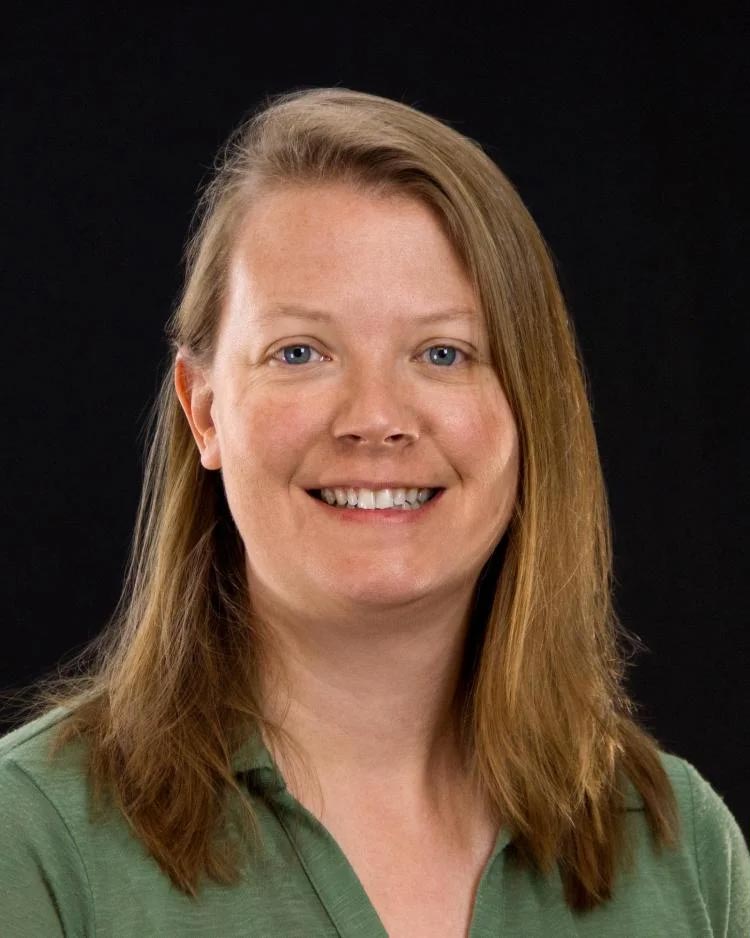
Heather Lewandowski. Credit: CU Boulder
“That’s like standing right in front of a campfire, and as you back away, it gets a lot hotter,” Mason said. “It makes no sense.”
Some scientists suspect that especially tiny flares, or “nanoflares,” which are too small for even the most advanced telescopes to spot, may be responsible. If such events exist, they may pop up across the sun on a nearly constant basis. And, the theory goes, they could add up to make the corona toasty. Think of boiling a pot of water using thousands of individual matches.
The students’ results cast doubt on this theory, Mason said, although he thinks it’s too early to say for sure.
“I was hoping our result was going to be different. I still feel like nanoflares are an important driver of coronal heating,” Mason said. “But the evidence from our paper suggests the opposite. I’m a scientist. I have to go where the evidence is pointing.”
Peak pandemic times
The effort began at the height of the COVID-19 pandemic.
In spring 2020, CU Boulder, like most universities around the country, had moved its courses entirely online. Lewandowski, however, faced a predicament: She was teaching a class on hands-on research called “Experimental Physics I” that fall, and she had nothing for her students to do.
“This was peak pandemic times,” Lewandowski said. “It’s sometimes hard to remember back to what life was like then. These students were very isolated. They were really stressed.”
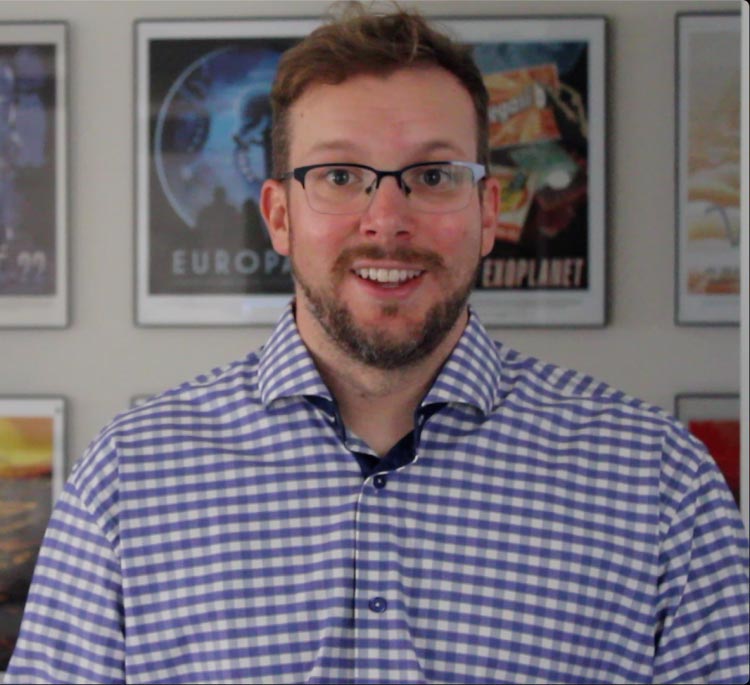
James Mason. Credit: CU Boulder
Mason, who was then a researcher at the Laboratory for Atmospheric and Space Physics (LASP) at CU Boulder, offered an idea.
The scientist had long wanted to dig into the mathematics of solar flares. In particular, he had tried examining a dataset of thousands of flares that occurred between 2011 and 2018 and had been spotted by instruments in space. They included the National Oceanic and Atmospheric Administration’s Geostationary Operational Environmental Satellite (GOES) series and NASA’s Miniature X-ray Solar Spectrometer (MinXSS), a CubeSat mission designed and built at LASP.
The problem: There were just too many flares to examine on his own.
That’s when Mason and Lewandowski turned to the students for help.
Mason explained that you can infer details about the behavior of nanoflares by studying the physics of larger flares, which scientists have observed directly for decades.
To do just that, students split into groups of three or four and picked a normal flare they wanted to analyze over the course of the semester. Then, through a series of lengthy calculations, they added up how much heat could each of these events pour into the sun’s corona.
Their calculations painted a clear picture: The sum of the sun’s nanoflares likely wouldn’t be powerful enough to heat up its corona to millions of degrees Fahrenheit.
Educational experiences
What is making the corona so hot isn’t clear. A competing theory suggests that waves in the sun’s magnetic field carry energy from inside the sun to its atmosphere.
But the study’s actual findings aren’t its only important results. Lewandowski said her students were able to have opportunities that are rare for scientists and engineers so early in their careers—to learn first-hand about the collaborative and often-messy way that scientific research works in the real world.
“We still hear students talking about this course in the halls,” she said. “Our students were able to build a community and support each other at a time that was really tough.”
Reference: “Coronal Heating as Determined by the Solar Flare Frequency Distribution Obtained by Aggregating Case Studies” by James Paul Mason, Alexandra Werth, Colin G. West, Allison Youngblood, Donald L. Woodraska, Courtney L. Peck, Arvind J. Aradhya, Yijian Cai, David Chaparro, James W. Erikson, Koushik Ganesan, T. R. Geerdts, Thi D Hoang, Thomas M. Horning, Yan Jin, Haixin Liu, Noah Lordi, Zheng Luo, Thanmay S. Menon, Josephine C. Meyer, Emma E Nelson, Kristin A. Oliver, Jorge L Ramirez Ortiz, Andrew Osborne, Alyx Patterson, Nick Pellatz, John Pitten, Nanako Shitara, Daniel Steckhahn, Aseem Visal, Hongda Wang, Chaoran Wang, Evan Wickenden, John Wilson, Mengyu Wu, Nikolay Yegovtsev, Ingrid H Zimmermann, James Holland Aaron, Jumana T. Abdullah, Jonathan M. Abrams, Riley Abrashoff, Andres B. Acevedo, Iker Acha, Daniela M. Meza Acosta, Megan M. Adam, Dante Q. Adams, Kalvyn N Adams, Elena R Adams, Zainab A. Akbar, Ushmi H. Akruwala, Adel Al-Ghazwi, Batool H. Alabbas, Areej A. Alawadhi, Yazeed A. Alharbi, Mohammed S. Alahmed, Mohammed A. Albakr, Yusef J. Albalushi, Jonathan Albaum, Ahmed Aldhamen, Nolan Ales, Mohammad Alesmail, Abdulelah Alhabeeb, Dania Alhamli, Isehaq Alhuseini, Suhail Alkaabi, Tameem Alkhezzi, Mohamed Alkubaisi, Nasser Allanqawi, Martin Allsbrook, Yousef A. Almohsen, Justin Thomas Almquist, Teeb Alnaji, Yousef A Alnasrallah, Nicholas Alonzi, Meshal Alosaimi, Emeen Alqabani, Mohammad Alrubaie, Reema A. Alsinan, Ava L. Altenbern, Abdullah Altokhais, Saleh A. Alyami, Federico Ameijenda, Hamzi Amer, Meggan Amos, Hunter J. Anderson, Carter Andrew, Jesse C Andringa, Abigail Angwin, Gabreece Van Anne, Andrew Aramians, Camila Villamil Arango, Jack. W. Archibald, Brian A. Arias-Robles, Maryam Aryan, Kevin Ash, Justin Astalos, N. S. Atchley-Rivers, Dakota N. Augenstein, Bryce W. Austin, Abhinav Avula, Matthew C. Aycock, Abdulrahman A. Baflah, Sahana Balaji, Brian Balajonda, Leo M Balcer, James O. Baldwin, David J Banda, Titus Bard, Abby Barmore, Grant M. Barnes, Logan D. W. Barnhart, Kevin M. Barone, Jessica L. Bartman, Claire Bassel, Catalina S Bastias, Batchimeg Bat-Ulzii, Jasleen Batra, Lexi Battist, Joshua Bay, Simone Beach, Sara Beard, Quinn I Beato, Ryan Beattie, Thomas Beatty, Tristan De La Beaujardiere, Jacob N. Beauprez, M. G. Beck, Lily Beck, Simone E. Becker, Braden Behr, Timothy A. Behrer, Joshua Beijer, Brennan J. Belei, Annelene L. Belknap, Aislyn Bell, Caden Bence, Evan Benke, Naomi Berhanu, Zachary D. Berriman-Rozen, Chrisanna Bertuccio, Owen A. Berv, Blaine B. Biediger, Samuel J Biehle, Brennen Billig, Jacob Billingsley, Jayce A. Billman, Connor J. Biron, Gabrielle E. Bisacca, Cassidy A. Blake, Guillermo Blandon, Olivia Blevins, Ethan Blouin, Michal Bodzianowski, Taylor A. Boeyink, Matthew Bondar, Lauren Bone, Alberto Espinosa De Los Monteros Bonilla, William T Borelli, Luke R. Borgerding, Troy Bowen, Christine Boyer, Aidan Boyer, Aidan P. Boyle, Tom Boyne, Donovan Branch, Ariana E. Brecl, David J. Brennan, Alexander J Brimhall, Jennifer L. Brockman, Sarah Brookins, Gabriel T. Brown, Cameron L. Brown, Ryan Brown, Jordi Brownlow, Grant Brumage-Heller, Preston J. Brumley, Samuel Bryan, A. Brzostowicz, Maryam Buhamad, Gigi Bullard-Connor, J. R. Ramirez Bunsow, Annemarie C. Burns, John J. Burritt, Nicholas David Burton, Taylor Burton, Celeste Busch, Dylan R. Butler, B. W. Buxton, Malena C. Toups, Carter C. Cabbage, Breonna Cage, Jackson R. Cahn, Andrew J Campbell, Braden P. Canales, Alejandro R. Cancio, Luke Carey, Emma L. Carillion, Michael Andrew Carpender, Emily Carpenter, Shivank Chadda, Paige Chambers, Jasey Chanders, Olivia M. Chandler, Ethan C. Chang, Mitchell G. Chapman, Logan T. Chapman, S. Chavali, Luis Chavez, Kevin Chen, Lily Chen, Sam Chen, Judy Chen, Jenisha Chhetri, Bradyn Chiles, Kayla M. Chizmar, Katherine E Christiansen, Nicholas A. Cisne, Alexis Cisneros, David B. Clark, Evelyn Clarke, Peter C Clarkson, Alexis R. Clausi, Brooke Cochran, Ryan W. Coe, Aislinn Coleman-Plante, Jake R. Colleran, Zachary Colleran, Curran Collier, Nathaniel A. Collins, Sarah Collins, Jack C. Collins, Michael Colozzi, Aurora Colter, Rebecca A. Cone, Thomas C. Conroy, Reese Conti, Charles J. Contizano, Destiny J. Cool, Nicholas M. Cooper, Jessica S Corbitt, Jonas Courtney, Olivia Courtney, Corben L. Cox, Wilmsen B. Craig, Joshua B. Creany, Anastasia Crews, K. A. Crocker, A. J. Croteau, Christian J. Crow, Zoe Cruse, Avril Cruz, Tyler L. Curnow, Hayden Current, Riley T. Curry, Libby Cutler, Aidan St. Cyr, Frederick M. Dabberdt, Johnston Daboub, Olivia Damgaard, Swagatam Das, Emma A. B. Davis, Elyse Debarros, Sean Deel, Megan E. Delasantos, Tianyue Deng, Zachary Derwin, Om Desai, Kai Dewey, John S. Dias, Kenzie A. Dice, R. Dick, Cyrus A. Dicken, Henry Dietrick, Alexis M. Dinser, Alyssa M. Dixon, Thomas J. Dixon, Helen C. Do, Chris H Doan, Connor Doane, Joshua Dodrill, Timothy Doermer, Lizbeth Montoya Dominguez, J. Dominguez, Emerson N. Domke, Caroline R. Doran, Jackson A. Dorr, Philip Dorricott, Danielle C. Dresdner, Michael Driscoll, Kailer H. Driscoll, Sheridan J. Duncan, Christian Dunlap, Gabrielle M. Dunn, Tien Q. Duong, Tomi Oshima Dupeyron, Peter Dvorak, … Michaela Wagoner, Steven P. Wallace, Logan Wallace, Caroline Waller, Jiawei Wang, Keenan Warble, N. R. D. Ward-Chene, James Adam Watson, Robert J. Weber, Aidan B. Wegner, Anthony A Weigand, Amanda M. Weiner, Ayana West, Ethan Benjamin Wexler, Nicola H. Wheeler, Jamison R. White, Zachary White, Oliver S. White, Lloyd C. Whittall, Isaac Wilcove, Blake C. Wilkinson, John S. Willard, Abigail K. Williams, Sajan Williams, Orion K. Wilson, Evan M. Wilson, Timothy R. Wilson, Connor B. Wilson, Briahn Witkoff, Aubrey M. Wolfe, Jackson R. Wolle, Travis M. Wood, Aiden L. Woodard, Katelynn Wootten, Catherine Xiao, Jianing Yang, Zhanchao Yang, Trenton J. Young, Isabel Young, Thomas Zenner, Jiaqi Zhang, Tianwei Zhao, Tiannie Zhao, Noah Y. Zhao, Chongrui Zhou, Josh J Ziebold, Lucas J. Ziegler, James C. Zygmunt, Jinhua Zhang, and H. J. Lewandowski, 9 May 2023, The Astrophysical Journal.
DOI: 10.3847/1538-4357/accc89
CU Boulder co-authors of the new study include Alexandra Werth, postdoctoral researcher at JILA; Colin West, teaching associate professor in physics; Allison Youngblood, astrophysicist at LASP now at the NASA Goddard Space Flight Center; Donald Woodraska, data systems team lead at LASP; and Courtney Peck, data systems software engineer at LASP and the Cooperative Institute for Research in Environmental Sciences (CIRES).
Funding for the research came from NASA through the MinXSS mission and the U.S. National Science Foundation through the STROBE Science & Technology Center and JILA Physics Frontier Center.


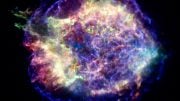

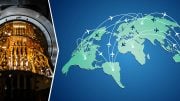
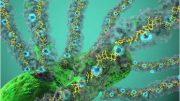

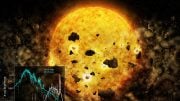

Be the first to comment on "Solar Sleuths: How 1,000 Undergraduates Helped Solve the Sun’s Hottest Mystery"